Sambo: A Guide to the Powerful Russian Martial Art
Table of Contents
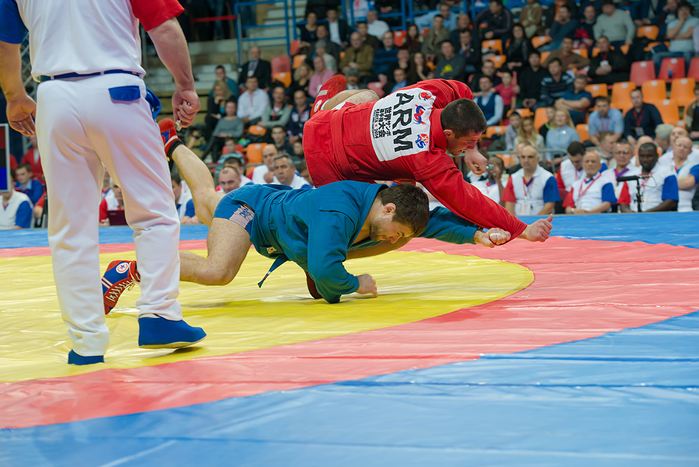
Sambo is a dynamic and versatile martial art that embodies a fascinating fusion of combat techniques and competitive sporting elements. Rooted in the former Soviet Union, Sambo emerged in the early 20th century as a response to the need for a comprehensive fighting system that could equip soldiers, athletes, and even civilians with effective self-defense skills.
Drawing influences from judo, jujitsu, and traditional wrestling, Sambo is a blend of various grappling techniques, throws, joint locks, and chokes that can be adapted for both real-life combat scenarios and competitive sports.
In this post, we will cover the history of Sambo, explore its unique styles, discuss the MMA fighters who use Sambo and compare it to other martial arts. Regardless of your interest in martial arts or your curiosity about the field of self-defense, Sambo’s compelling story is sure to captivate and inspire you.
The History of Sambo
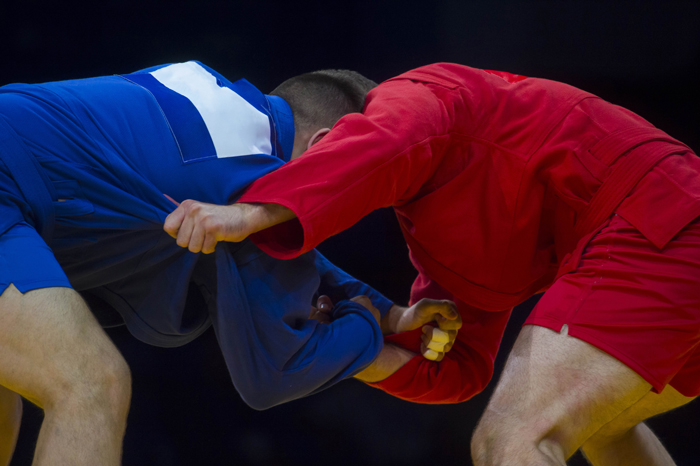
Sambo is a versatile and dynamic martial art that has a rich history of blending cultures and traditions. The origins of Sambo can be traced back to the early 20th century, specifically to the former Soviet Union. It was born out of a necessity to develop an effective fighting system that would equip soldiers and athletes with the skills to defend themselves. The term “Sambo” itself is an acronym derived from the Russian phrase “SAMozashchita Bez Oruzhiya,” which translates to “self-defense without weapons.”
In the rough years following the Russian Revolution of 1917, there was a rising interest in martial arts and physical fitness. This interest coincided with the need for the Soviet Union to strengthen its military and athletic capabilities. Various martial arts from different regions were studied, assimilated, and adapted to create a new martial art that would become Sambo. Influences from judo, jujitsu, and traditional wrestling styles, such as Kurash, played a major role in the development of Sambo’s techniques and principles.
Throughout the 20th century, Sambo continued to evolve and grow in popularity. It found its way into military training, sports competitions, and civilian self-defense courses. The Soviet government actively promoted Sambo as a symbol of national pride and as a means to showcase the strength of Russian athletes. The sport gained international recognition, and in 1984, the International Sambo Federation (FIAS) was formed to govern and regulate Sambo competitions globally.
After the Soviet Union’s dissolution in 1991, former republics developed their own Sambo styles, including Combat Sambo and Sport Sambo. In the 21st century, Sambo expanded globally, becoming an official sport and featured in multi-sport events. Its inclusivity attracted practitioners from diverse backgrounds, developing an international community for Sambo.
Moreover, the practicality of Sambo techniques caught the attention of law enforcement and military personnel worldwide. Various special forces units and police departments started incorporating elements of Sambo into their training programs, recognizing its efficiency in real-life combat situations.
The Founding Fathers of Sambo: Spiridonov and Oshchepkov
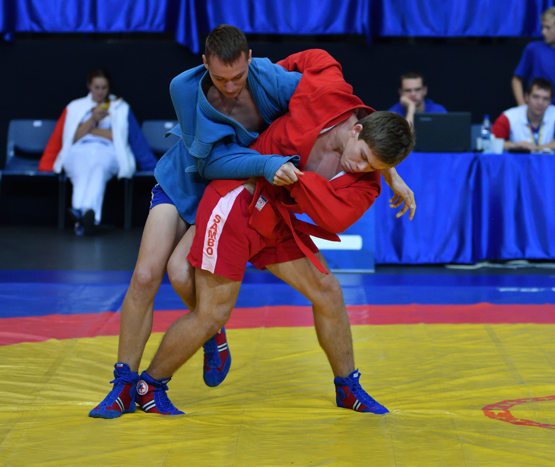
Viktor Spiridonov and Vasili Oshchepkov are the two pioneering martial artists who played critical roles in shaping Sambo into the formidable combat system and sport it is today.
Viktor Spiridonov, born in 1890, was an accomplished wrestler and a master of various grappling styles. His expertise in traditional wrestling styles like Kurash formed the foundation of Sambo’s groundwork. Spiridonov’s deep knowledge of freestyle wrestling and jujitsu also provided valuable insights into the art’s technical grappling aspects, especially when it came to throws and takedowns. He was instrumental in integrating these techniques into the emerging martial art, helping to create a comprehensive and effective system for combat and self-defense.
Vasili Oshchepkov, born in 1892, brought an international perspective to the development of Sambo. His journey began when he traveled to Japan to study judo under the legendary judoka, Kano Jigoro, at the Kodokan Institute in Tokyo. Oshchepkov’s dedication and skill in judo earned him a black belt and a position as an assistant instructor at the prestigious academy. After returning to Russia in 1914, he shared his knowledge of judo and collaborated with Spiridonov to create a new martial art that combined elements from judo, jujitsu, and traditional wrestling styles. Oshchepkov’s expertise in judo enriched Sambo’s arsenal of techniques, particularly in the areas of joint locks and chokes, adding another layer of versatility to the art.
The collaboration between Spiridonov and Oshchepkov proved to be a pivotal moment in the birth of Sambo. Their combined knowledge and expertise from diverse martial arts backgrounds allowed them to create a well-rounded system that incorporated the best aspects of each fighting style. Sambo’s development gained momentum, and its popularity spread throughout the Soviet Union.
However, despite their shared vision, Spiridonov and Oshchepkov had different approaches and emphases in their teachings. While Spiridonov’s expertise in traditional wrestling styles influenced the groundwork and the wrestling takedowns and techniques in Sambo, Oshchepkov’s judo background contributed to the development of techniques that focused on leverage, off-balancing, and submission holds.
Unfortunately, the promising partnership between the two founding fathers of Sambo was short-lived. During the turbulent period of the Stalinist era in the late 1930s, Vasili Oshchepkov faced false accusations of being a Japanese spy due to his connections with Judo and Japan. Tragically, he was arrested and executed in 1938, leaving behind a legacy that has been preserved through his contributions to Sambo’s technical aspects.
In contrast, Viktor Spiridonov continued to contribute to the Sambo martial art’s growth and popularity. His dedication to the martial art extended to teaching and promoting Sambo as an official combat system and sport within the Soviet Union. Spiridonov’s influence is still evident in Sambo’s foundational principles and techniques, which have been passed down through generations of Sambo practitioners.
Today, the legacy of Spiridonov and Oshchepkov lives on in the global practice of Sambo. Their collaborative efforts and individual contributions laid the groundwork for the great martial art that we see today. Their names will forever be remembered as the pioneers of the Sambo community, leaving a lasting impact on the world of martial arts.
Different Styles of Sambo
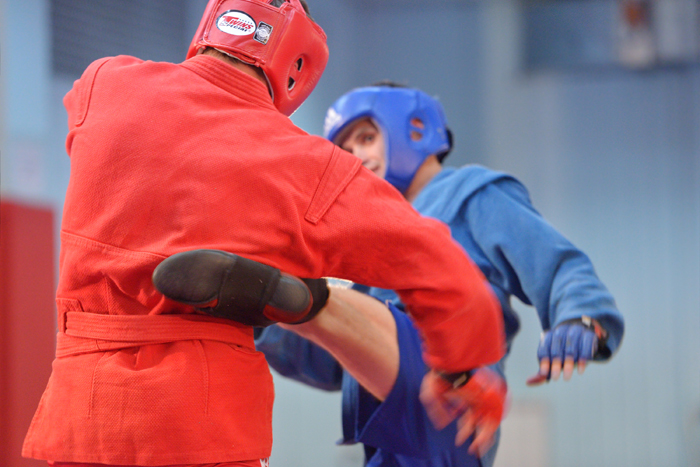
There are different styles of Sambo, each with its own techniques, rules, and use cases. Sport Sambo, Combat Sambo, Freestyle Sambo, and Beach Sambo are the styles that are most common. Each one of these Sambo styles is great and has its own individual uses; let’s check them out.
Sport Sambo

Sport Sambo is the most competitive and regulated form of martial art. It focuses on athletic capabilities and technical skills. Throws, takedowns, ground grappling, joint locks, leg locks, and chokes are all part of Sport Sambo.
In Sport Sambo competitions, participants wear jackets known as kurtkas, and points are awarded for executing clean and controlled techniques. The goal is to outscore the opponent or achieve a submission victory through joint locks or chokes. Sport Sambo is governed by the rules and regulations of the International Sambo Federation (FIAS) and is recognized as an international sport practiced in many countries around the world.
Freestyle Sambo

Freestyle Sambo is a less formal and more open version of Sport Sambo that allows practitioners to draw inspiration from Brazilian Jiu Jitsu. It encourages experimentation and creativity with submissions and takedowns. It is an adaptation of Sport Sambo, and Freestyle Sambo competitions may have fewer restrictions on techniques compared to Sport Sambo. It gives participants more freedom to showcase their skills and versatility and makes the sport more inviting.
Combat Sambo

Combat Sambo evolved from Sport Sambo and was further adapted for military applications. It was designed to train soldiers and special forces in hand-to-hand combat techniques to be effective in real combat scenarios. Combat Sambo places a greater emphasis on practicality and real-life situations.
While it includes many of the same techniques as Sport Sambo, Combat Sambo practitioners also learn striking techniques, including punches, kicks, and elbow strikes. Unlike Sport Sambo, Combat Sambo is typically practiced without the traditional kurtka or jacket. This no-gi training allows practitioners to focus on techniques that can be applied in a variety of settings, including when not wearing a uniform or traditional martial arts attire.
Combat Sambo is the style that most resembles modern MMA fighting, and just like mixed martial arts, it has a very relaxed ruleset, meaning almost anything goes in Combat Sambo. Some competitions have a few rules, but for the most part, this is the style of Sambo that is the most complete in terms of what is permitted. Combat Sambo, although used in the military and special forces, is still popular amongst practitioners too.
Combat Sambo is widely used by military and special forces units in countries that have adopted it as part of their combat training. It provides soldiers with the skills and confidence to handle close-quarters combat situations. Overall, Combat Sambo is one of the best Sambo styles when looking for a complete fighting style.
Beach Sambo

Beach Sambo is an unusual type of modern Sambo that has only been practiced in the last few years. It is a bit like Sport Sambo but slightly modified compared to Sport Sambo and it takes place on a beach. The style consists of throws and takedowns, but without submissions or striking. Sport Sambo is quite a new form of Sambo, so I look forward to seeing if it grows in popularity like the other styles of Sambo.
Sambo in Mixed Martial Arts
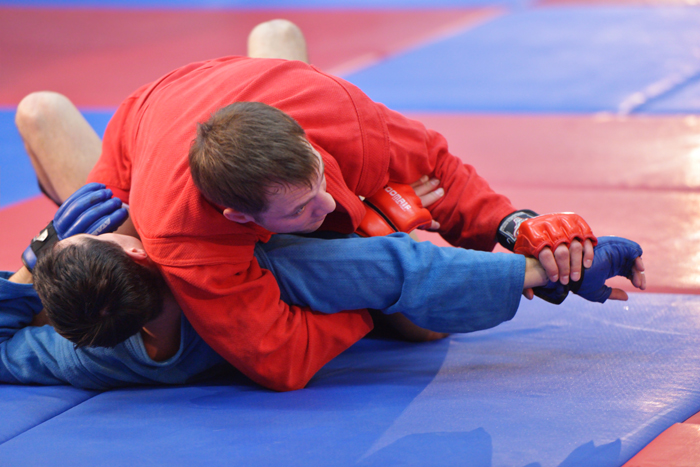
In recent years, Sambo fighters have gained much notoriety within the mixed martial arts community. UFC Champions such as Khabib Nurmagomedov and Islam Makhachev have achieved great success in their MMA careers, elevating the status of Sambo fighters in the world of professional fighting.
Khabib Nurmagomedov and Islam Makhachev have become renowned for their high level of wrestling and ground fighting, which have been well adapted into mixed martial arts. As UFC champions, these two have elevated the status of Sambo, making it world-famous.
Who are the Best Sambo Fighters in MMA?

Khabib Numargamedov once said, “If Sambo was easy, it would be called Jiu jitsu.” This famous quote by one of the best MMA fighters to grace the octagon has been repeatedly used by Sambo practitioners. Khabib was one of the best Sambo fighters in MMA, and he secured first place in both the 2009 and 2010 World Combat Sambo Federation (WCSF) World Championships. However, there are a number of notable Sambo practitioners currently fighting in MMA who have also made their mark on the sport. Here is a list of some of the best Sambo fighters:
Fedor Emelianenko
Andrei Arlovski
Islam Makhachev
Dan Severn
Khabib Nurmagomedov
Merab Dvalishvili
These fighters have proven that Sambo is practical at a very high level in MMA, and we will likely see more Sambo fighters enter mixed martial arts in the future.
Frequently Asked Questions
Why is Sambo so effective?

Combat Sambo is an effective martial art because there are almost no limitations as to what is allowed. This means Combat Sambo allows practitioners to practice whatever is most useful. Like mixed martial arts, Combat Sambo is a mixture of striking takedowns and submissions. This has proven to be a great formula for winning fights. Other forms of Sambo, like Sport Sambo, are also very effective, as the wrestling orientation allows fighters to dictate where a fight goes.
There is a concept in modern combat sports, particularly MMA, that the person who controls where the fight goes is likely to win the fight. This concept does lean towards wrestling-based styles like Sambo, Judo, and Greco-Roman wrestling practitioners establishing themselves well in mixed martial arts. It doesn’t come as a surprise that fighters with backgrounds in martial arts like Sambo are having such great success in professional fighting.
What Are the Differences Between Sambo and MMA?

MMA is a hybrid combat sport that allows fighters to use techniques from various martial arts, including striking from Muay Thai, boxing, and kickboxing. Grappling is also used in MMA (including wrestling, Brazilian Jiu-Jitsu, judo, and Sambo). However, Sport Sambo just includes the grappling aspects of throws, takedowns, and submissions.
Combat Sambo is the style that is most similar to MMA as it allows for almost any type of striking technique, plus the takedowns of Sport Sambo. There is still a difference, though, as all types of Sambo competitions take place in a controlled environment with specific rules, and Sambo fighters wear protective gear. MMA, however, places an emphasis on winning the fight through almost any means possible, and protective gear is not used at a professional level.
Adaptability and endurance are vital in MMA, and your ability to switch between striking, submissions, and wrestling is a must. This means MMA fighters train with the idea of constantly switching styles and doing so in a real fighting environment rather than a tournament setting.
What Are the Differences Between Sambo and BJJ?
Despite having an emphasis on ground grappling and submission techniques, Brazilian Jiu-Jitsu (BJJ) and Sambo both have core fundamental features that distinguish them. BJJ fighters place a significant emphasis on ground grappling, leveraging technique and control in order to submit opponents. With practitioners wearing a Gi during training and competition, the Gi becomes an integral part of gripping and choking techniques.
Sambo, on the other hand, emphasizes both standing and ground techniques while drawing inspiration from judo and traditional wrestling methods. Sambo is suitable for both self-defense and sport due to its adaptability, which enables smooth transitions between throws, takedowns, and submissions. Sambo’s main emphasis is on the flexibility of throws, takedowns, and submissions, while BJJ’s main focus is on ground control, submissions, and Gi-based submission techniques.
Sambo vs. Wrestling Which is better?
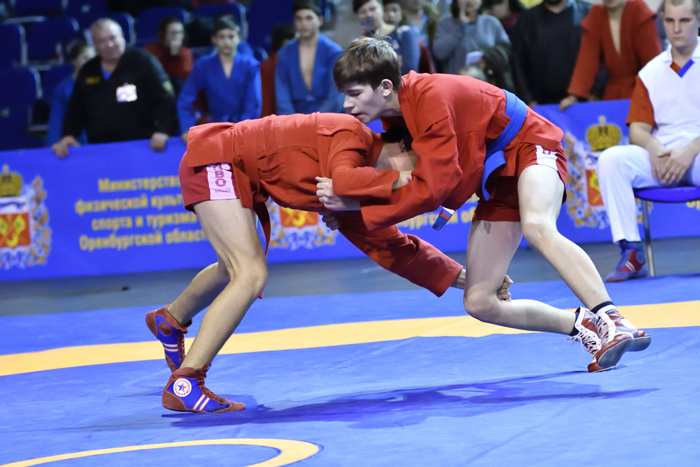
Sport Sambo is a comprehensive martial art that incorporates techniques from judo, jujitsu, and traditional wrestling styles. It focuses on both standing and ground techniques, including throws, takedowns, joint locks, and chokes. Sambo practitioners, known as “Samboists,” wear kurtkas (jackets) in competitions, and points are awarded for executing clean and controlled techniques.
In contrast, wrestling has a much older history and can be traced back to ancient civilizations. It is primarily a grappling sport that involves trying to take down and control an opponent to pin their shoulders to the ground or force them out of a designated area. Unlike Sambo, wrestling typically does not involve submission techniques. Wrestlers compete in various styles, such as folkstyle, freestyle, and Greco-Roman wrestling, each with its own set of rules and techniques.
There is a big debate in the martial arts world about which one is better. I believe we won’t know the exact answer until cross-competition tournaments are held between Sambists and wrestlers. Nontheless, both are very effective grappling-based martial arts, and either one is great to practice.
Is Sambo an Olympic sport?
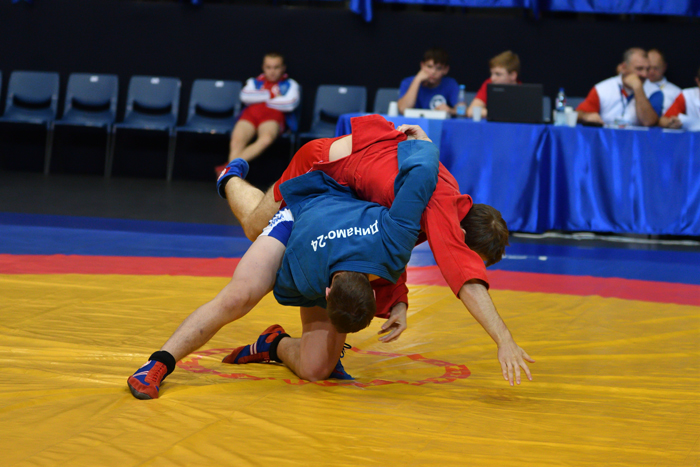
Over the years, Sambo has gained popularity and recognition on the international stage, with numerous competitions and federations dedicated to promoting the sport globally. The International Sambo Federation (FIAS) has been actively working towards Olympic recognition and inclusion.
Sambo has recently gained International Olympic Committee recognition, which means there is a strong possibility that Sambo could one day be part of the Olympic Games. Let’s hope that we see Sambo become an official Olympic sport soon.
Summary
Sambo is a very effective martial art, and I believe that is why we have seen such a rise in the popularity of Sambo. The fact that MMA champions like Khabib Nurmagomedov have made undefeated careers using Sambo as a base for their fighting style is truly amazing. This is likely to inspire more Sambo fighters to enter mixed martial arts, and Sambo’s journey to become an Olympic sport means that we might see it compete at an Olympic Games soon. All this is exciting for the sport of Sambo, and I hope we will see this great sport prosper even more in the years to come.









